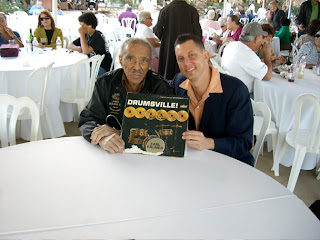Earl Palmer and Daniel Glass
|
Put on an old blues or r&b record. You always know the drums are there at the very center of it all, but sometimes it’s hard to hear exactly what the drummer is doing. (The bass drum is usually the hardest for me to find on an old record.) But that’s exactly the sound and the feel that I want-- so when I started trying to learn how to play drums I looked for some help. That’s when I learned about The Commandments of Early Rhythm and Blues Drumming by Daniel Glass and fellow drummer Zoro. It’s a goldmine, packed with drumbeats from a hundred or so r&b classics, but also packed with history-- stories and information about people like Earl Palmer and Fred Below. I’ve only skimmed the surface of what it contains, but it’s there for me.
Then yesterday Glass, a regular member of the Royal Crown Review, came to Seattle and put on a free drum clinic at a local drum store called The Drum Exchange. I took my seven year old, who likes to steal and scatter my drum sticks and knows how to do a rock beat or two. (At one point during the clinic Glass thrilled him by saying, “We all started with something like this, right?” and then played Raff’s first drum beat.) The Drum Exchange provided a beautiful room for the clinic, with a raised stage so that everyone (there had to be 50-75 people-- a full house) could see. Rafferty and I were in the first row. It was all a bit like Christmas. Glass and the Drum Exchange passed out dozens of gifts-- drumsticks, cymbals, t-shirts. Rafferty got a pair of sticks of his own, and a chart of r&b beats for his wall.
But the real gift was Glass. For more than two hours he told and played the history of drums and rhythm in America, starting with military and marching beats that got turned “ragged” deep down in Louisiana close to New Orleans. He told about the introduction of tom toms from china, bass pedals, cymbals from Turkey, high hats, smaller bass drums and ride cymbals. He put it all in the context of slavery, the gay nineties, prohibition, World War II, the swing era, be-bop, rock and roll, and finally, even a moment or two about Ringo Starr on Ed Sullivan. (If Glass saw it first hand he is remarkably well preserved.) And he did all this with incredible respect for the drummers and history that came before him. Glass is a true historian. He’s gone back and talked to them, interviewed them, listened to every beat, even played with them. (He can tell you when the first time a drummer his his crash cymbal on the "one" instead of the "four," and what recording first featured a high hat.) And he can play. That, of course, was the other treat-- when Glass would turn to his left handed drum set and play. Rafferty was squirming a bit during the lecture portions (prohibition? be-bop?) but no one squirmed during the drum exhibitions.
(Well, I take that back. I was squirming. Whenever I see someone so good I wonder why in hell’s name I even bother to head down to my basement and irritate my neighbors. As the saying goes, you can’t get there from here.)
But-- if you ever get a chance to hear Glass talk or play, take advantage.
And if you love early r&b, get his book.
As for my squirming-- it doesn’t matter. I can’t get there-- but like the duffer who once in a while hits a soaring drive-- I like trying.

No comments:
Post a Comment